
Georgia is a beautiful state for birding! Many birds live in and migrate through Georgia’s forests, wetlands, and other natural habitats.
Some of those birds are gorgeous Ruby-throated Hummingbirds! This species is a common summer resident, but a few other rare hummingbird species have also occurred.
How many hummingbirds live in Georgia? Where can you see them, and how can you identify them?
On this page
Georgia’s Hummingbird Populations
We all know Georgia as the southeastern state, however, this does not necessarily mean there are lots of hummingbirds. In order to get a better understanding, we delved into eBird data.
Even though there is only one resident hummingbird in Georgia, you can occasionally spot some rarer visitors. Here’s who you can see!
Ruby-throated Hummingbird
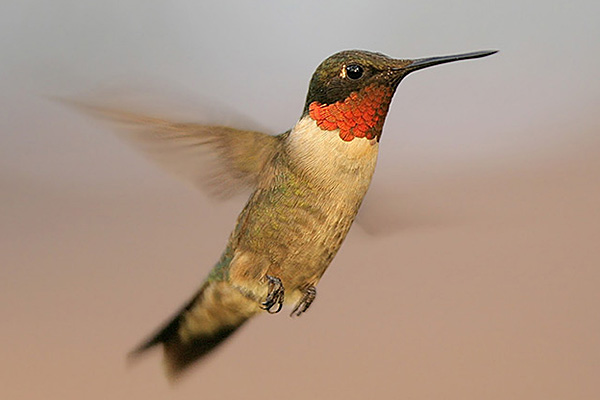
Photograph © Greg Lavaty.
Scientific name: Archilochus colubris
Length: 3.75 inches
Wingspan: 4.5 inches
The Ruby-throated Hummingbird is the common, small hummingbird of eastern North America. Although other, rare species can occasionally occur, at eastern feeders, this species is the de-facto hummingbird.
Males are green above, have some olive on their belly, a white chest and semi-collar, and a tiny white spot behind each eye. True to their name, they also have a beautiful, ruby-red throat. However, as with most hummingbirds, those colors only show in certain lighting.
They also have a dark, slightly forked tail, and a long, needle-like beak. Female Ruby-throated Hummingbirds look quite different from their male counterparts! They are also green above but have a grayish throat, and white tips on their tail.
Ruby-throated Hummingbirds live in Georgia throughout the year, but there are much more birds during the summer months.
Key identifications:
- Red throat and white semi-collar.
- Dark, slightly forked tail.
- Females have a white spot behind their eyes, a hint of a dusky mask, and the tail of perched birds is longer than their wingtips.
Rufous Hummingbird
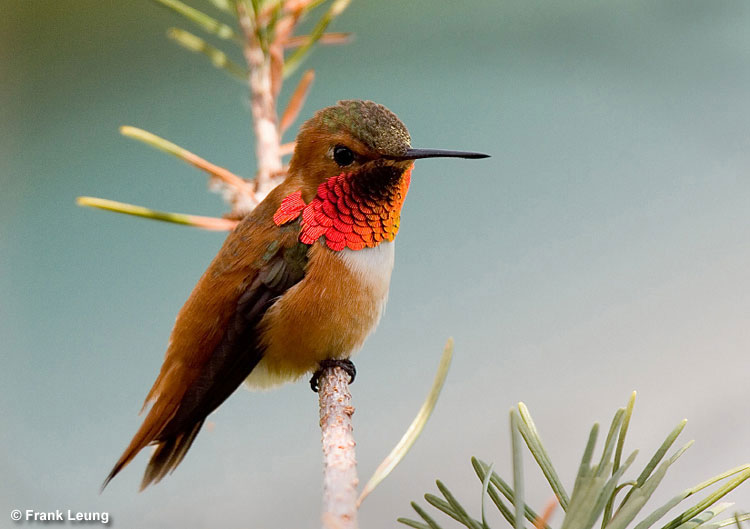
Scientific name: Selasphorus rufus
Length: 3.75 inches
Wingspan: 4.5 inches
Rufous Hummingbirds breed in the coniferous forests of the Pacific Northwest and then fly to central Mexico for the winter. Some even breed as far north as southern Alaska!
Males are pretty, pumpkin orange hummingbirds with white on the upper part of their chest, and an orange-red throat. Some males also have green on their back and crown.
Female Rufous Hummingbirds are green above and white below with pale rufous highlights on their underparts. They also have rufous on the base of their tail, and white tips on their outer tail feathers.
Even though Rufous Hummingbirds are associated with the West, as years pass, they have become more and more popular in Eastern states. If you’re lucky, you can spot them during winter.
Key identifications:
- Pumpkin orange plumage, especially on the back and head.
- Orange-red throat.
- Rufous on the base of their tail and rump, and broad outer tail feathers.
Allen’s Hummingbird (rare)
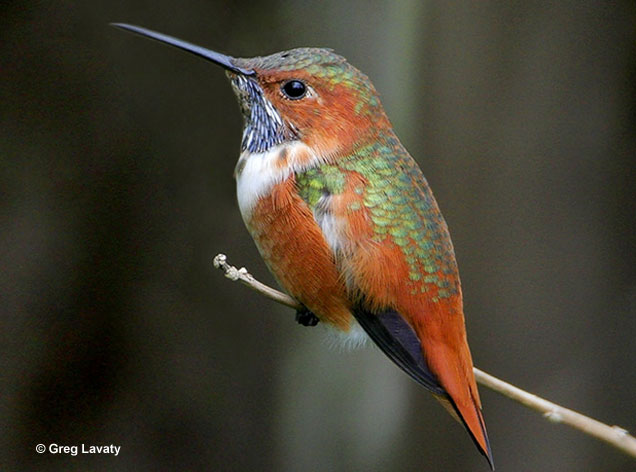
Scientific name: Selasphorus sasin
Length: 3.75 inches
Wingspan: 4.25 inches
The Allen’s Hummingbird is one of the key hummingbird species of California. Except for a small part of Oregon, this pretty little bird mostly breeds in coastal scrub in The Golden State.
In addition to their breeding range, we can recognize Allen’s Hummingbirds by their orange underparts and tail, and green upperparts. Males have a beautiful red-orange throat patch while females have bits of red-orange and green spotting on their throat.
Females also have orange on their rump and the base of their tail. Both sexes have a pale spot behind their eyes, white chest, and a slightly curved beak.
In their breeding range, Allen’s Hummingbirds are pretty easy to see. They like to forage at flowering bushes and also visit feeders. Like other hummingbirds, they also catch small insects in flight.
After breeding, Allen’s Hummingbirds migrate to a fairly small area in the mountains of central Mexico, but if they get lost, they can venture off their path.
Key identifications:
- Orange underparts, green upperparts, and long, pointed tail feathers.
- Males have a red-orange throat.
- Females have a pale orange eyebrow.
Calliope Hummingbird (rare)
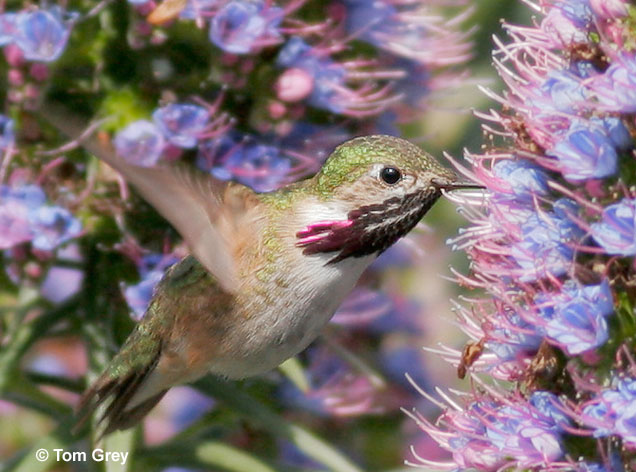
Scientific name: Selasphorus calliope
Length: 3.25 inches
Wingspan: 4.25 inches
Calliope Hummingbirds have the distinction of being the smallest bird in North America. These feathered sprites are green above, pale buffy or pale greenish below, and have a short, squared tail.
They also have shorter, straighter beaks than other hummingbirds and a pale mark behind each eye. Male Calliopes have rose-red streaks on their throats while females have fine, dark streaking.
Calliope Hummingbirds breed in open coniferous woodlands from British Columbia to Utah and parts of central California. During summer and migration to and from Mexico, we can see Calliope Hummingbirds at flowering bushes and feeders.
They can also show up at feeders well east of their range and have become annual visitors to Florida and some other places. Perhaps to avoid being chased away by other, larger hummingbirds, Calliopes are pretty quiet and good at keeping out of sight.
If you see a tiny hummingbird suddenly sneak into the feeder, it could be a Calliope!
Key identifications:
- Small hummingbird with a squared tail and straight, fairly short beak.
- No rufous in its tail.
- Streaked throat.
Broad-billed Hummingbird (rare)
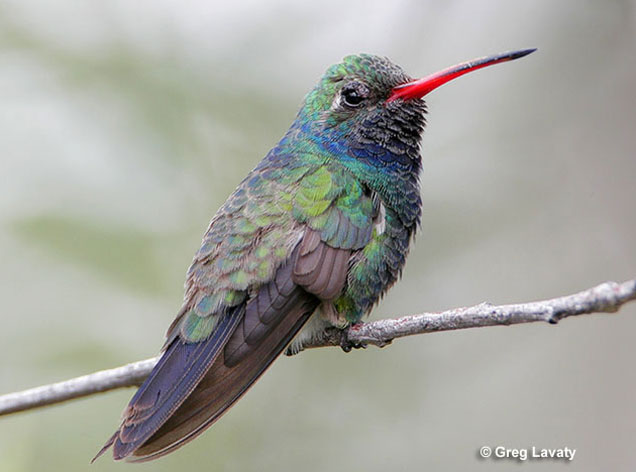
Scientific name: Cyanthus latirostris
Length: 4 inches
Wingspan: 5.75 inches
The Broad-billed Hummingbird is a small to medium-sized, distinctive hummingbird with green upperparts, a broad, forked tail, and a red beak with a dark tip. Males also have a violet-blue throat, and dark, blue-green underparts.
Females have grayish underparts, a white line going back from their eyes, and a dusky mask.
Broad-billed Hummingbirds occur from southeastern Arizona and adjacent New Mexico to Mexico. In the USA, they mostly live along streams on canyons. However, further south, we also see this hummingbird species in a variety of subtropical and tropical habitats.
Most of the birds that nest in the USA migrate south for the winter. However, some Broad-billed Hummingbirds have learned to migrate east.
Like some other western hummingbirds, they go there to take advantage of the many hummingbird feeders. This species is usually bold and easy to see, especially at feeders. However, they can also forage at a wide variety of flowering shrubs.
Key identifications:
- Dark blue-green underparts.
- Red beak with a dark tip.
- Females have dingy gray underparts and a pale line going back from their eyes.
Black-chinned Hummingbird (rare)
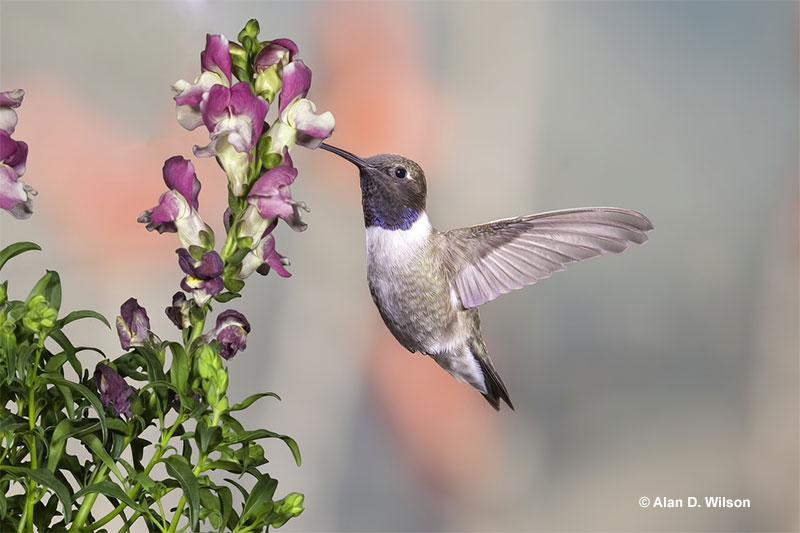
Scientific name: Archilocus alexandri
Length: 3.75 inches
Wingspan: 4.75 inches
Black-chinned Hummingbirds replace the Ruby-throated Hummingbird west of the Rocky Mountains and in parts of central and southern Texas. They are green above and dusky gray below with a white semi-collar and small pale spot behind their eyes.
Males have a beautiful dark purple throat with a black chin, and a black, slightly forked tail. Females have a dusky gray throat, grayish crown, hint of a dark mask, and a slightly forked tail with white tips on the outer tail feathers.
On perched females, the wings nearly reach the end of their tail. These pretty hummingbirds are common at feeders from parts of southern British Columbia to northern Mexico. They also feed from a variety of small tubular flowers and live in riparian zones, brushy habitats, and gardens.
In late summer, Black-chinned Hummingbirds migrate to western Mexico for the winter. However, some also winter at feeders.
Key identifications:
- Dark throat with a white semi-collar.
- Grayish belly and black, slightly forked tail.
- On females, look for the grayish crown, long, slightly curved beak, and rounded wing tips that nearly reach the end of their tail.
Frequently Asked Questions
Are hummingbirds common in Georgia?
Yes, hummingbirds are common in Georgia. The Ruby-throated Hummingbird is common and some other rare migrants can also occur.
Are there rare hummingbirds in Georgia?
Yes, there are rare hummingbirds in Georgia. Rare hummingbird species migrate in Georgia every year.
How long do hummingbirds stay in Georgia?
Hummingbirds stay in Georgia all year long. Ruby-throated Hummingbirds are present in the summer months, and rare migrants stay in Georgia during fall and winter.
More in Georgia: Most common birds | Hawks | Owls | Woodpeckers | State Bird

